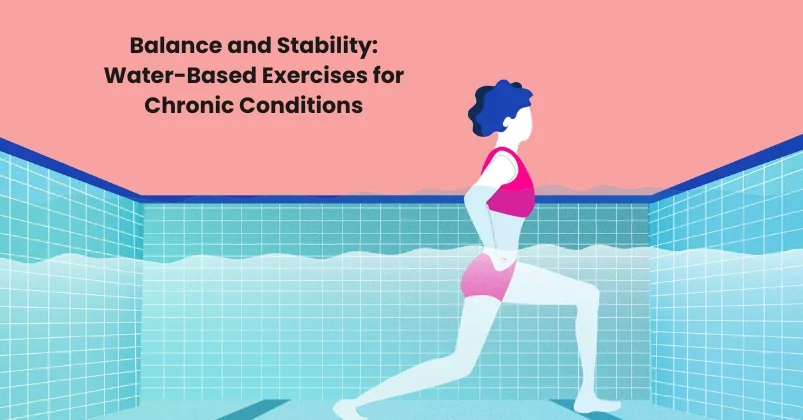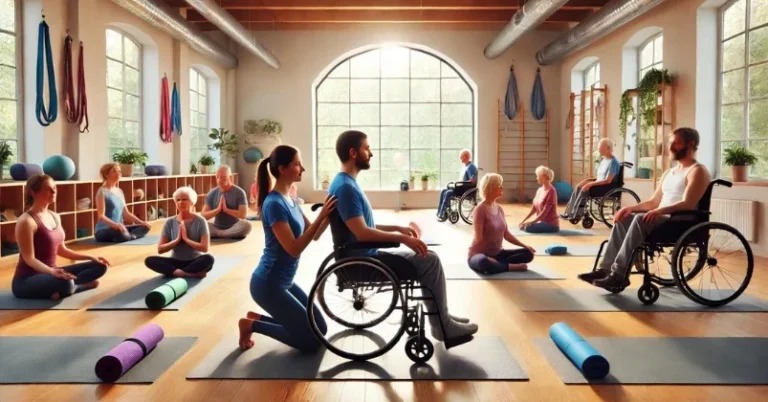Balance and Stability: Water-Based Exercises for Chronic Conditions
Water-based exercises can offer numerous benefits for individuals with chronic conditions, particularly regarding improving balance and stability. These exercises are often less strenuous on the joints, making them ideal for those with conditions such as arthritis or fibromyalgia. Additionally, the buoyancy of the water can help to reduce the risk of falls and injuries, while also providing resistance to help strengthen muscles.
Research has shown that aquatic therapy can be particularly effective in improving balance and stability in individuals with chronic conditions. A study published in the International Journal of Rehabilitation Research found that aquatic exercise was more effective than land-based exercise for improving balance, motor function, cardiorespiratory fitness, and functional independence in stroke patients. Other studies have also shown that aquatic therapy can be beneficial for individuals with conditions such as multiple sclerosis, Parkinson's disease, and osteoporosis.
Overall, water-based exercises can provide a safe and effective way for individuals with chronic conditions to improve their balance and stability. By reducing the risk of falls and injuries, these exercises can help to improve overall quality of life and independence.
Understanding Balance and Stability
Balance and stability are essential for performing daily activities and preventing falls, especially for those with chronic conditions. Balance is the ability to maintain the center of mass over the base of support, while stability is the ability to control the body's position and motion. Good posture and coordination are also important factors in maintaining balance and stability.
Poor balance and stability can lead to falls, which can cause serious injury or even death. According to the Centers for Disease Control and Prevention, falls are the leading cause of injury-related deaths among adults aged 65 years and older. Water-based exercises can be an effective way to improve balance and stability in those with chronic conditions.
Water-based exercises are low-impact and can reduce the risk of injury while providing a challenging workout. The buoyancy of water reduces the impact on joints and muscles, making it easier to perform exercises without causing pain or discomfort. Water also provides resistance, which can help improve muscle strength and coordination.
Good posture is important for maintaining balance and stability. Poor posture can lead to muscle imbalances, which can affect the body's ability to maintain its center of mass over the base of support. Water-based exercises can help improve posture by strengthening the muscles that support the spine and improving overall body awareness.
Coordination is also important for maintaining balance and stability. Coordination involves the ability to move the body in a controlled and efficient manner. Water-based exercises can help improve coordination by challenging the body to maintain its balance and stability while performing different movements.
Overall, water-based exercises can be an effective way to improve balance, stability, posture, and coordination in those with chronic conditions. By incorporating water-based exercises into a regular exercise routine, individuals can improve their overall health and reduce the risk of falls and injuries.
The Role of Water-Based Exercises
Water-based exercises have gained popularity in recent years, especially among individuals with chronic conditions. These exercises are low-impact and can be an effective way to improve balance, stability, and overall fitness.
One of the key benefits of water-based exercises is that they provide a supportive environment for the body. The buoyancy of the water reduces the impact on joints, making it an ideal exercise option for individuals with arthritis, osteoporosis, or other chronic conditions that affect mobility.
In addition to reducing joint stress, water-based exercises can also help improve cardiovascular health. Swimming and other aerobic water-based exercises can help increase heart rate and improve overall fitness levels.
Water-based exercises can also be an effective way to improve balance and stability. The resistance of the water provides a challenging workout for muscles, which can help improve strength and coordination. This is particularly important for individuals with conditions such as Parkinson's disease or multiple sclerosis, which can affect balance and coordination.
Furthermore, water-based exercises can be a fun and social way to stay active. Group classes such as water aerobics or aqua Zumba can provide a supportive and motivating environment for individuals looking to improve their fitness levels.
Overall, water-based exercises can be a valuable addition to any fitness routine, particularly for individuals with chronic conditions. These exercises provide a low-impact, supportive environment that can help improve balance, stability, and overall health.
Benefits for Chronic Conditions
Water-based exercises can be beneficial for individuals with chronic conditions. It is a low-impact form of exercise that can help improve balance and stability, reduce pain and inflammation, and increase overall physical function. Here are some specific benefits for individuals with common chronic conditions:
Arthritis
Arthritis is a common chronic condition that affects the joints. Water-based exercises can provide a safe and effective way to improve joint flexibility and reduce pain and inflammation. The buoyancy of water can help reduce the weight-bearing load on the joints, making it easier to move and exercise.
Stroke
Stroke survivors may experience weakness on one side of the body, making it difficult to perform daily activities. Water-based exercises can help improve balance and coordination, and increase overall strength and mobility. It can also help reduce the risk of falls, which is a common concern for stroke survivors.
Diabetes
Exercise is an important part of diabetes management. Water-based exercises can help improve blood sugar control, reduce the risk of heart disease, and improve overall physical function. It can also be a safe and effective way to exercise for individuals with diabetic neuropathy, a condition that affects the nerves and can cause pain and numbness in the feet and legs.
Osteoarthritis
Osteoarthritis is a common form of arthritis that affects the joints. Water-based exercises can help improve joint flexibility and reduce pain and inflammation. It can also be a safe and effective way to exercise for individuals with osteoarthritis who may have difficulty with weight-bearing exercises.
Chronic Obstructive Pulmonary Disease (COPD)
COPD is a chronic lung disease that can make it difficult to breathe. Water-based exercises can help improve lung function, reduce shortness of breath, and increase overall physical function. It can also be a safe and effective way to exercise for individuals with COPD who may have difficulty with traditional forms of exercise.
Cancer
Cancer and cancer treatments can cause fatigue and weakness. Water-based exercises can help improve overall physical function, reduce fatigue, and improve the quality of life for individuals with cancer. It can also be a safe and effective way to exercise for individuals undergoing cancer treatment.
Dementia
Dementia can cause a decline in cognitive function and physical ability. Water-based exercises can help improve balance and coordination, reduce the risk of falls, and improve overall physical function for individuals with dementia. It can also be a safe and enjoyable form of exercise for individuals with dementia who may have difficulty with traditional forms of exercise.
Anxiety and Depression
Exercise is effective in reducing symptoms of anxiety and depression. Water-based exercises can provide a relaxing and enjoyable way to exercise, which can help reduce stress and improve mood. It can also be a safe and effective way to exercise for individuals who may have difficulty with traditional forms of exercise due to anxiety or depression.
Specific Water-Based Exercises
Water-based exercises are an excellent way to improve balance, stability, and overall fitness for individuals with chronic conditions. Here are some specific water-based exercises that can help improve balance, strength, flexibility, and endurance.
Balance Exercises
Balance exercises are essential for individuals with chronic conditions to improve their stability and reduce the risk of falls. Some popular water-based balance exercises include:
- Single-leg balance: Stand on one leg and hold for 10-30 seconds. Repeat on the other leg.
- Tandem stance: Stand with one foot in front of the other and hold for 10-30 seconds. Repeat with the other foot in front.
- Side leg lift: Stand with one hand on the pool wall and lift one leg out to the side. Repeat with the other leg.
Strength Training
Strength training in water is an excellent way to improve muscle strength and tone without putting excess strain on joints. Some popular water-based strength training exercises include:
- Water walking: Walk in the pool, lifting your knees high and swinging your arms for added resistance.
- Water jogging: Jog in the pool, lifting your knees high and swinging your arms for added resistance.
- Water resistance exercises: Use water weights or resistance bands to perform exercises like bicep curls, tricep extensions, and chest presses.
Flexibility Exercises
Flexibility exercises are essential for maintaining range of motion and reducing stiffness in joints. Some popular water-based flexibility exercises include:
- Water stretches: Stand in chest-deep water and stretch your arms, legs, and back.
- Water yoga: Perform yoga poses in the pool, such as downward dog, tree pose, and warrior pose.
- Water tai chi: Perform tai chi movements in the pool, such as cloud hands, wave hands, and brush knees.
Endurance Training
Endurance training in water is an excellent way to improve cardiovascular fitness and endurance. Some popular water-based endurance training exercises include:
- Water aerobics: Perform aerobic exercises in the pool, such as jumping jacks, high knees, and cross-country skiing.
- Water jogging: Jog in the pool, lifting your knees high and swinging your arms for added resistance.
- Water treading: Tread water in the deep end of the pool for as long as possible.
Overall, water-based exercises offer a low-impact, effective way for individuals with chronic conditions to improve their balance, strength, flexibility, and endurance. Incorporating these exercises into a regular fitness routine can help improve overall health and reduce the risk of falls and other injuries.
Safety and Precautions
Water-based exercise is generally considered a safe and effective way to improve balance and stability in people with chronic conditions. However, it is important to take certain precautions to ensure your safety during exercise.
Falls and Injuries
Falls are a common concern for people with chronic conditions, and water-based exercise can help reduce the risk of falls by improving balance and stability. However, it is important to take certain safety measures to avoid injuries during exercise.
- Always warm up before exercise, and cool down afterward.
- Wear appropriate footwear to prevent slipping and falling.
- Use handrails or other support systems when getting in and out of the pool.
- Avoid high-impact exercises that could cause injury, such as jumping or diving.
Safety
Water-based exercise is generally considered safe for people with chronic conditions, but it is important to take certain precautions to ensure your safety during exercise.
- Always exercise under the supervision of a trained professional.
- Make sure the pool is properly maintained and free of hazards.
- Stay hydrated during exercise, and take breaks as needed.
- Be aware of your surroundings and avoid collisions with other swimmers.
Heart Health
Water-based exercise can be a great way to improve heart health in people with chronic conditions. However, it is important to take certain precautions to avoid overexertion and other risks.
- Always talk to your doctor before starting a new exercise program.
- Monitor your heart rate during exercise, and stop if you experience any chest pain or other symptoms.
- Avoid exercises that are too strenuous or that cause shortness of breath.
Role of Physical Therapists
Physical therapists play a crucial role in helping individuals with chronic conditions improve their balance and stability through water-based exercises. They are trained professionals who work closely with patients to develop personalized rehabilitation plans that address their specific needs and goals.
Physical therapists use a variety of techniques to help patients improve their balance and stability, including aquatic therapy, balance training, and functional mobility exercises. Aquatic therapy, in particular, is effective in improving postural balance in chronic patients compared to subacute patients.
The primary goal of physical therapy is to help patients regain their independence and improve their overall quality of life. By working with a physical therapist, patients can learn how to safely perform exercises that will help them build strength and improve their balance and stability.
Physical therapists also play an important role in educating patients and their families about the importance of exercise and rehabilitation in managing chronic conditions. They can guide proper nutrition, hydration, and lifestyle modifications that can help patients achieve their goals and improve their overall health and well-being.
In conclusion, physical therapists are essential members of the healthcare team for individuals with chronic conditions. They provide personalized rehabilitation plans that address the unique needs of each patient and help them improve their balance and stability through water-based exercises and other techniques. By working closely with a physical therapist, patients can regain their independence and improve their overall quality of life.
Chan, K., Phadke, C. P., Stremler, D., et al. (2012). The effect of water-based exercises on balance in persons post-stroke: a randomized controlled trial. Clinical Rehabilitation, 26(10), 886-899.
Impact on Quality of Life
Water-based exercise has been shown to have a positive impact on the quality of life of individuals with chronic conditions. A review of 18 studies found that water-based exercise can effectively improve mood, depression, anxiety, tension, and fall efficacy in both healthy older adults and those with chronic disease.
Improving quality of life is an essential goal of rehabilitation interventions for individuals with chronic conditions. Water-based exercise can benefit individuals by improving their physical activity levels, which in turn can lead to an improved quality of life.
In particular, water-based exercise is beneficial for individuals with mobility limitations. Walking difficulties can have a major impact on stroke survivors, limiting their ability to independently perform daily activities and hurting their quality of life. Loss of balance when walking is common after stroke, with 70% of stroke survivors living at home reported to fall within a year of their stroke. Water-based exercise has been shown to improve balance and mobility in individuals with stroke and other chronic conditions.
Overall, water-based exercise can have a significant positive impact on the quality of life of individuals with chronic conditions. By improving mobility and physical activity levels, water-based exercise can lead to improved mood, reduced anxiety and depression, and increased fall efficacy.
Research and Studies
Water-based exercise training has been studied extensively in individuals with chronic respiratory diseases, including chronic obstructive pulmonary disease (COPD). A randomized controlled trial aimed to determine the effectiveness of water-based exercise training in improving exercise capacity, incremental shuttle walk distance, endurance shuttle walk distance, and chronic respiratory disease questionnaire (CRDQ) scores in individuals with COPD who have coexisting obesity or musculoskeletal or neurological conditions. The study found that water-based exercise training was effective in improving exercise capacity and CRDQ scores, but not in improving shuttle walk distances. Additionally, no serious adverse events were reported during the study (PubMed)
Another study aimed to study the effect of an 8-week water-based exercise program on respiratory function, muscle strength, balance ability, and exercise capacity in individuals with COPD. Fourteen stable COPD participants were recruited and randomized into a water-based exercise or a land-based exercise group. The study found that the water-based exercise group showed significant improvements in respiratory function, muscle strength, balance ability, and exercise capacity compared to the land-based exercise group (Frontiers)
A systematic review and meta-analysis of 23 randomized controlled trials found that aquatic exercise had a significant positive effect on improving physical function, and quality of life, and reducing symptoms of pain and depression in individuals with various chronic conditions, including COPD. The study also found that aquatic exercise had a better effect on physical function and quality of life than land-based exercise (PubMed)
In conclusion, water-based exercise training is an effective and safe mode of exercise for individuals with chronic respiratory diseases. It has been shown to improve exercise capacity, respiratory function, muscle strength, balance ability, and quality of life. Additionally, it is more effective than land-based exercise in improving physical function and quality of life.
FAQs
Water aerobics can improve balance and coordination by providing a low-impact environment that reduces the risk of falls and injuries. The resistance of the water also provides a natural challenge for the body, which can help improve muscle strength and balance. Additionally, the buoyancy of the water can help support the body and reduce stress on the joints, making it easier to perform movements and maintain balance.
Water-based exercises can provide several benefits for seniors, including improved cardiovascular health, increased muscle strength and flexibility, and better balance and coordination. The low-impact nature of water-based exercises also makes them a safe and effective way for seniors to stay active and maintain their overall health and well-being.
Water aerobics can be particularly beneficial for those with chronic diseases, such as arthritis, fibromyalgia, and chronic obstructive pulmonary disease (COPD). The low-impact nature of water-based exercises can help reduce pain and inflammation, while the buoyancy of the water can help support the body and reduce stress on the joints and respiratory system. Additionally, water aerobics can improve cardiovascular health, muscle strength, and balance, which can help manage symptoms and improve overall quality of life.
The top 5 benefits of water aerobics include:
1. Improved cardiovascular health
2. Increased muscle strength and flexibility
3. Better balance and coordination
4. Reduced stress on the joints and respiratory system
5. Low-impact, safe, and enjoyable exercise option
Many exercises can help improve balance, but some of the best options include:
1. Standing on one leg
2. Walking heel-to-toe
3. Tai chi
4. Yoga
5. Pilates
6. Water aerobics
Hydrotherapy involves using water to treat various conditions, such as arthritis, fibromyalgia, and chronic pain. It typically involves exercises and movements that are performed in warm water, which can help reduce pain and inflammation and improve mobility and flexibility. Land-based exercise, on the other hand, refers to exercises and movements that are performed on dry land, such as walking, running, and weightlifting. While both forms of exercise can be beneficial, hydrotherapy may be a better option for those with chronic pain or conditions that make it difficult to perform land-based exercises.








